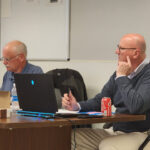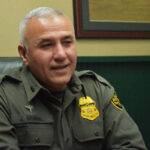HOULTON, Maine — Paint can be used to cover up flaws in walls, but all the paint in the Houlton Sherwin Williams store would be inadequate to fill the sinkhole that opened up behind the North Street store last week
According to Al Hanscom, general manager for the Houlton paint supply store, a sinkhole about two feet in diameter and more than 30-feet deep was discovered behind the business on Oct. 20, 2015.
“I usually pull my truck up to the back door and come in that way,” Hanscom said. “When I went to step out of my truck, I found this hole. It was just there overnight.”
Hanscom said a small indentation was first noticed in the pavement last year, which he had filled with asphalt. Never did he dream that small indentation would turn into a hole of this magnitude.
The store was closed from Tuesday, Oct. 20 until Wednesday, Oct. 28, as an engineer was called in to investigate. A fire inspector examined the property and determined there was no threat of a gas leak, which allowed the business to reopen. The hole is currently covered and the entire area has been fenced off.
Sherwin Williams’ parking lot is located behind the historic Blackhawk Putnam building. Built in 1813, it is the oldest standing framed residence building in Aroostook County. According to Houlton historian Leigh Cummings, the mid-18th century building served as a tavern, inn, courthouse and jail. One of its owners was Blackhawk Putnam, a veteran of the Civil War. It was listed on the National Register of Historic Places on Jan. 30, 1976.
“There are still marks on the windows in the cellar where the bars for the jail were located,” Cummings said.
So, is the sinkhole somehow connected to an elaborate underground jail tunnel system? Hanscom wasn’t sure, but wouldn’t rule it out either.
“The sinkhole actually curves a bit and there are some old pipes down in it,” Hanscom said. “It looks like it kind of goes toward the Blackhawk Building, so it makes me wonder.
“We want people to know that we are in fact back open,” Hanscom added. “Our next question, is ‘How do we fill in this hole?’”







